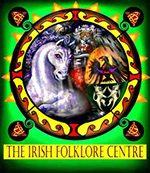The Tragic Fate of the Children of Lir This is a late 15th century creation and is the second of the ‘Three Sorrows of Storytelling’. It contains the themes of fosterage, a wicked stepmother, humans magicked into birds and centuries-long life ending in dust on return to human form. As with many tales a Christian twist has been given to it at the end. When the Tuatha Dé Danann were defeated by the Milesians, and retreated underground, they decided to appoint a king. From the five candidates, Bodhbh Dearg, one of the sons of Daghdha, was chosen. Another of the candidates, Lir of Sídh Fionnachaidh (‘the white field’, a cairn on Deadman’s Hill, County Armagh was deeply offended and cut himself off from his fellows.
After a few years, Lir’s wife died, and Bodhbh thought he might bring them together if he offered one of his three foster-daughters to Lir in marriage. Lir chose the eldest, Aobh. They were very happy and she bore him two sets of twins, a daughter and three sons. Sadly, she died during her second delivery. Lir was devastated. Bodhbh once again offered one of his foster-daughters and Lir took Aoife as his wife. They were also very content, and Aoife loved the children. But Aoife was barren and, as she got older, she became jealous of Lir’s great love for his children. She retired to her bed for a year claiming sickness and Lir was very worried about her.
During this time, in a distressed mental state, she plotted the destruction of the children. Seemingly recovered, she proposed a visit to her foster-father in his palace on the shore of Loch Dearg (Loch Derg on the Shannon) accompanied by the children. The girl, Fionnghuala, suspected her motives but was powerless. On the journey Aoife suggested to her servants that they kill the children; in horror they refused. The party reached Loch Dairbhreach (Loch Derravaragh, County Westmeath) and Aoife raised her sword to kill them, but relented and, instead, enchanted them with her druid’s wand. She turned them into swans and told them that they would have to spend three hundred years on that lake, three hundred on Sruth na Maoile (the Sea of Moyle between Ireland and Scotland) and three hundred off Irras Domhnann (Erris, County Mayo). They would only be released when a king’s son from the north is married to king’s daughter from the south. However she granted them the power of speech and the gift of singing. Aoife was forced to reveal her deed to Bodhbh. Bodhbh’s fury was extreme and he turned her into a demon (like the Mórrigna), to roam the earth for the rest of time. During their time on Loch Derravaragh the swans were kept company by the Tuatha Dé Danann, and the Milesians, who delighted in their singing. But the time came for them to leave for the inhospitable sea, first that of Moyle, around Kinbane Head off the Antrim coast, (web) and then to Erris for another six hundred years. They suffered extremes of cold, freezing sea and gale force winds.
During one fierce night, Fionnghuala thought she had lost her brothers, but they returned to her. Their only human contact off Antrim was when they were found by two of Bodhbh’s sons and received news of their family. While on Erris Fionnghuala received a message from God and pleaded ‘O God, who made heaven and earth and delivered the six hosts, save too this flock. Even the strong become weak through suffering.’ (8, p67) Their belief resulted in the end of their physical pain. When their nine hundred years were ended, they went back to Sídh Fionnachaidh to find it ruined and abandoned. Desolate, they returned to Inis Gluair (Inishglory, an island in the bay of Erris. One day their singing was heard by St Mochaomhóg, who treated them with great kindness. The Connacht king, Lairgnéan, had married the daughter of the king of Munster, Deoch. Hearing of the singing swans she demanded that her husband obtained them for her. Unable to refuse her, he went to St Mochaomhóg and tried to take them by force, at which point the enchantment was broken; they turned back into very ancient people.
Before they died, St Mochaomhóg baptised them and they were buried together as was their wish.
Author: Rod O’Donoghue
Email: rod@odonoghue.co.uk
